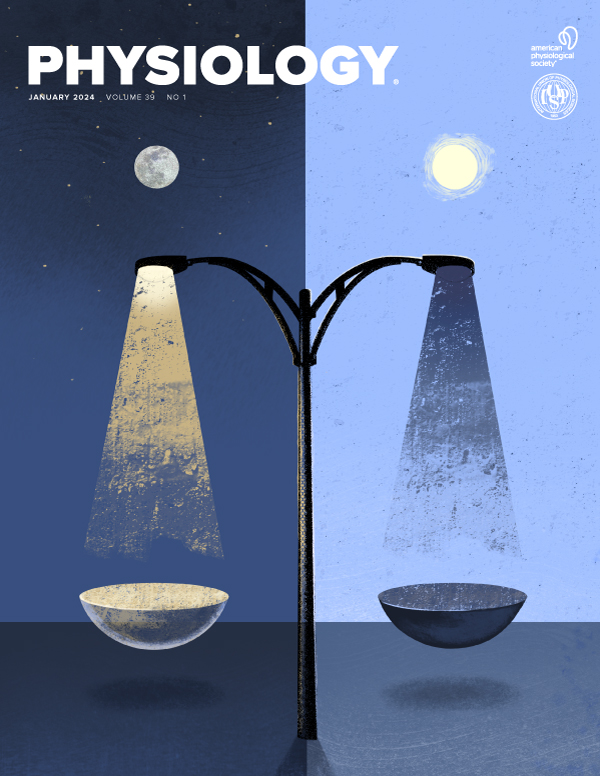The Effect of 0.1 Hz Blood Flow Oscillations on Microvascular Blood Flow Responses Following Severe Ischemia
IF 5.3
2区 医学
Q1 PHYSIOLOGY
引用次数: 0
Abstract
Background: We have shown that inducing 10 second (0.1 Hz) oscillations in arterial pressure and blood flow protects against reductions in tissue oxygenation during ischemia, independent of changes in macrovascular blood flow. However, it is unknown whether 0.1 Hz hemodynamic oscillations impacts microvascular function and vasodilatory capacity following severe ischemia. To examine this question, we assessed the reactive hyperemic response following a prolonged peripheral limb ischemia protocol with and without induced 0.1 Hz hemodynamic oscillations. Hypothesis: 0.1 Hz oscillations in blood pressure and blood flow will increase microvascular blood flow, assessed via reactive hyperemia following a 10-min period of ischemia. Methods: Thirteen healthy human participants (6M, 7F; 27.3 ± 4.2 y) completed two experimental protocols separated by ≥48 h. In both conditions, ischemia of the forearm was induced with a pneumatic cuff on the upper arm to decrease brachial artery blood velocity by ~70-80% from baseline. In the oscillation condition (OSC), 0.1 Hz oscillations in mean arterial pressure (MAP) and brachial artery blood flow were induced by inflating and deflating bilateral thigh cuffs every 5-s (10-s cycles; 0.1 Hz) throughout the forearm ischemia period. In the control condition (CON), the thigh cuffs were in place, but were inactive throughout the forearm ischemia period. Beat to beat arterial pressure was measured via finger photo plethysmography, and brachial artery diameter and blood velocity were measured via duplex Doppler ultrasound during baseline, ischemia, and the reperfusion period. The maximum mean brachial artery blood velocity, and 3-min area under the curve (AUC) of mean brachial artery blood velocity were used to determine the reactive hyperemia response. Results: The magnitude of forearm ischemia, indexed by the reduction in brachial artery conductance, was matched between conditions (CON: -74.8 ± 10.4% vs. OSC: -75.6 ± 6.7%, p=0.39). Reactive hyperemia was not different between conditions as indexed by maximum mean brachial artery blood velocity (CON: 36.4 ± 12.4 cm/s vs. OSC: 39.3 ± 11.2 cm/s, p=0.53) or 3-min brachial artery blood velocity AUC (CON: 1495 ± 744 (cm/s)2 vs. OSC: 1596 ± 804 (cm/s)2, p=0.74). Conclusion: Inducing 0.1 Hz hemodynamic oscillations during severe ischemia does not affect microvascular function, indexed by reactive hyperemia following release of the ischemic stimulus. A more direct measure of microvascular blood flow is needed to examine whether 0.1 Hz hemodynamic oscillations improves microvascular perfusion during ischemia. NIH Neurobiology of Aging & Alzheimer’s Disease Training Grant (T32 AG02049; KAD); American Heart Association Transformational Project Award (19TPA34910743; CAR); American Heart Association Predoctoral Fellowship (23PRE1018469; KAD); UNTHSC Physiology and Anatomy Seed Grant 2021 (CAR). This is the full abstract presented at the American Physiology Summit 2024 meeting and is only available in HTML format. There are no additional versions or additional content available for this abstract. Physiology was not involved in the peer review process.严重缺血后 0.1 赫兹血流振荡对微血管血流反应的影响
背景:我们已经证明,诱导动脉压力和血流量出现 10 秒(0.1 赫兹)的振荡可防止缺血期间组织氧合减少,而与大血管血流量的变化无关。然而,0.1 Hz 血流动力学振荡是否会影响严重缺血后的微血管功能和血管舒张能力还不得而知。为了研究这个问题,我们评估了有无诱导 0.1 赫兹血流动力学振荡的长期外周肢体缺血方案后的反应性高血容量反应。假设:血压和血流量的 0.1 赫兹振荡将增加微血管血流量,缺血 10 分钟后通过反应性充血进行评估。研究方法13 名健康人(6 名男性,7 名女性;27.3 ± 4.2 岁)完成了两个实验方案,两个方案之间相隔≥48 小时。在这两个条件下,用气动袖带在上臂诱导前臂缺血,使肱动脉血速比基线下降约 70-80%。在振荡条件(OSC)下,通过在整个前臂缺血期间每 5 秒钟(10 秒钟循环;0.1 Hz)对双侧大腿袖带进行充气和放气,诱导平均动脉压(MAP)和肱动脉血流出现 0.1 Hz 的振荡。在对照组(CON)条件下,大腿袖带处于原位,但在整个前臂缺血期间处于非活动状态。在基线期、缺血期和再灌注期,通过指光胸透测量每搏动脉压,并通过双工多普勒超声测量肱动脉直径和血流速度。最大平均肱动脉血速和平均肱动脉血速的 3 分钟曲线下面积(AUC)用于确定反应性充血反应。结果前臂缺血的程度(以肱动脉电导率的降低为指标)在不同条件下是一致的(CON:-74.8 ± 10.4% vs. OSC:-75.6 ± 6.7%,P=0.39)。以最大平均肱动脉血速(CON:36.4 ± 12.4 cm/s vs. OSC:39.3 ± 11.2 cm/s,p=0.53)或 3 分钟肱动脉血速 AUC(CON:1495 ± 744 (cm/s)2 vs. OSC:1596 ± 804 (cm/s)2,p=0.74)为指标,反应性充血在不同条件下没有差异。结论在严重缺血时诱导 0.1 Hz 血流动力学振荡不会影响微血管功能,缺血刺激释放后的反应性充血可作为指标。需要对微血管血流进行更直接的测量,以研究 0.1 赫兹血流动力学振荡是否能改善缺血时的微血管灌注。美国国立卫生研究院(NIH)老龄化与阿尔茨海默病神经生物学培训补助金(T32 AG02049;KAD);美国心脏协会转型项目奖(19TPA34910743;CAR);美国心脏协会博士前期奖学金(23PRE1018469;KAD);2021年UNTHSC生理学与解剖学种子补助金(CAR)。这是在 2024 年美国生理学峰会上发表的摘要全文,只有 HTML 格式。本摘要没有附加版本或附加内容。生理学未参与同行评审过程。
本文章由计算机程序翻译,如有差异,请以英文原文为准。
求助全文
约1分钟内获得全文
求助全文
来源期刊

Physiology
医学-生理学
CiteScore
14.50
自引率
0.00%
发文量
37
期刊介绍:
Physiology journal features meticulously crafted review articles penned by esteemed leaders in their respective fields. These articles undergo rigorous peer review and showcase the forefront of cutting-edge advances across various domains of physiology. Our Editorial Board, comprised of distinguished leaders in the broad spectrum of physiology, convenes annually to deliberate and recommend pioneering topics for review articles, as well as select the most suitable scientists to author these articles. Join us in exploring the forefront of physiological research and innovation.
 求助内容:
求助内容: 应助结果提醒方式:
应助结果提醒方式:


